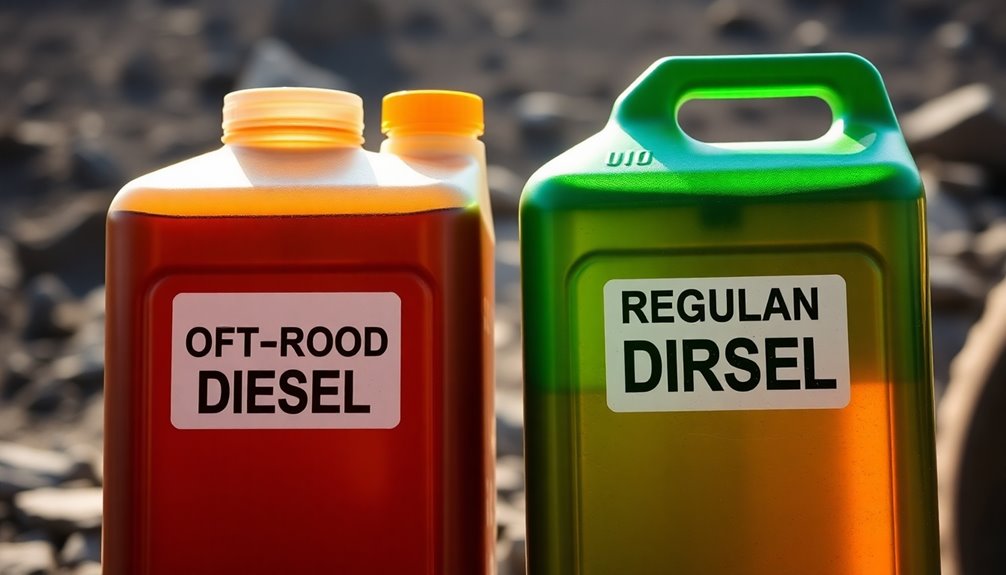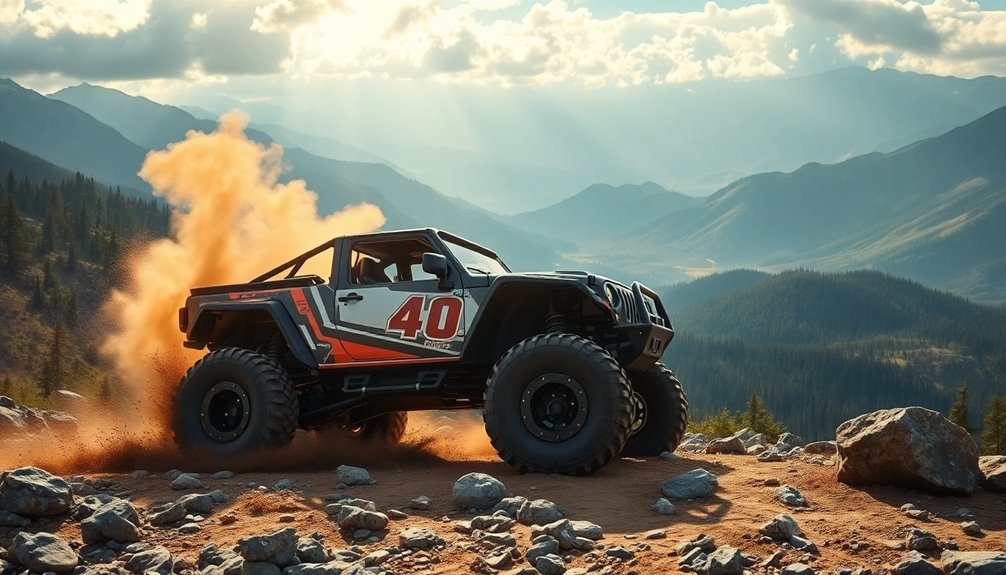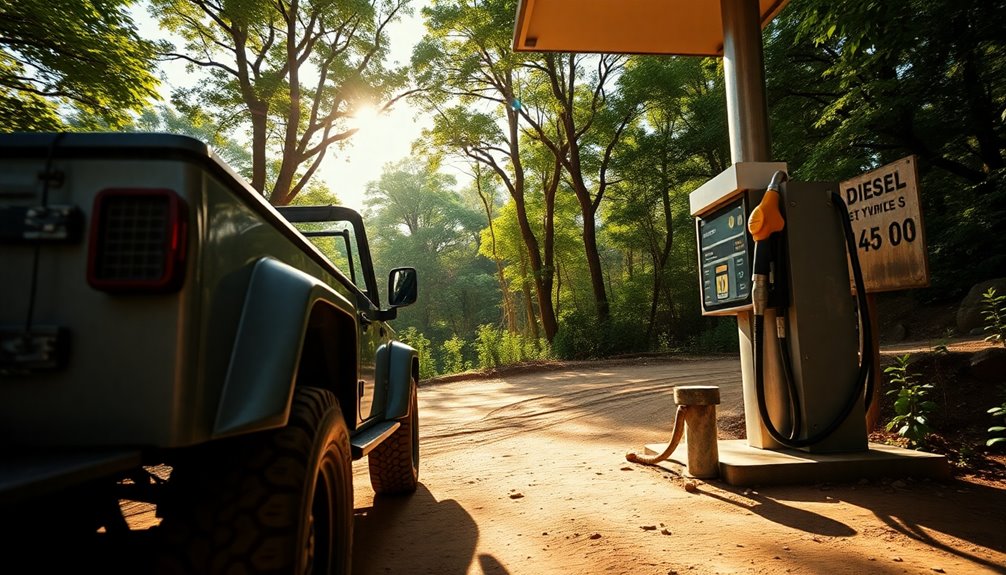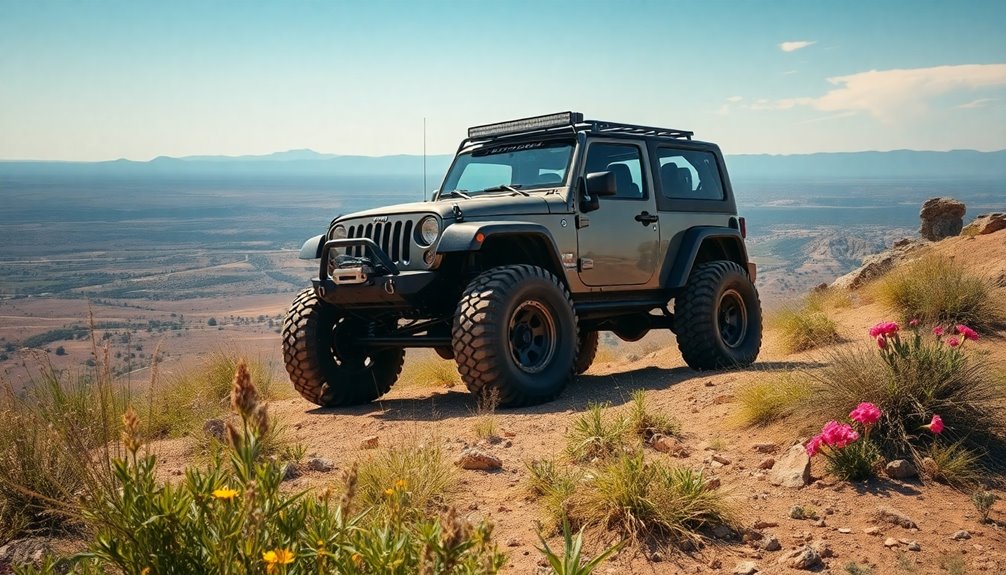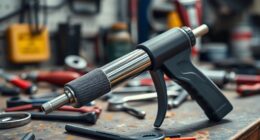Off-road diesel, often called red diesel, differs from regular diesel mainly in usage and tax status. You'll find regular diesel at gas stations, and it includes federal taxes, while off-road diesel is tax-exempt and intended for agricultural and construction machinery. Both types meet Ultra Low Sulfur Diesel (ULSD) standards, but off-road diesel can have a higher sulfur content and is dyed red for identification. You save about 25 cents per gallon with off-road diesel, but misuse in on-road vehicles can lead to hefty fines. Interested in how these differences could affect your operations? There's more to explore!
Key Takeaways
- Off-road diesel, or red diesel, is tax-exempt and dyed red, while regular diesel is subject to federal taxes and is clear in color.
- Both diesel types meet Ultra Low Sulfur Diesel (ULSD) specifications, but off-road diesel can contain higher sulfur levels.
- Off-road diesel is typically 25 cents cheaper per gallon than regular diesel due to its nontaxed status, benefiting industries like agriculture and construction.
- Misusing off-road diesel in on-road vehicles can lead to significant penalties, including fines up to $10,000.
- Proper training and compliance are essential to avoid legal issues and potential engine damage when using off-road diesel.
Overview of Diesel Fuel Types
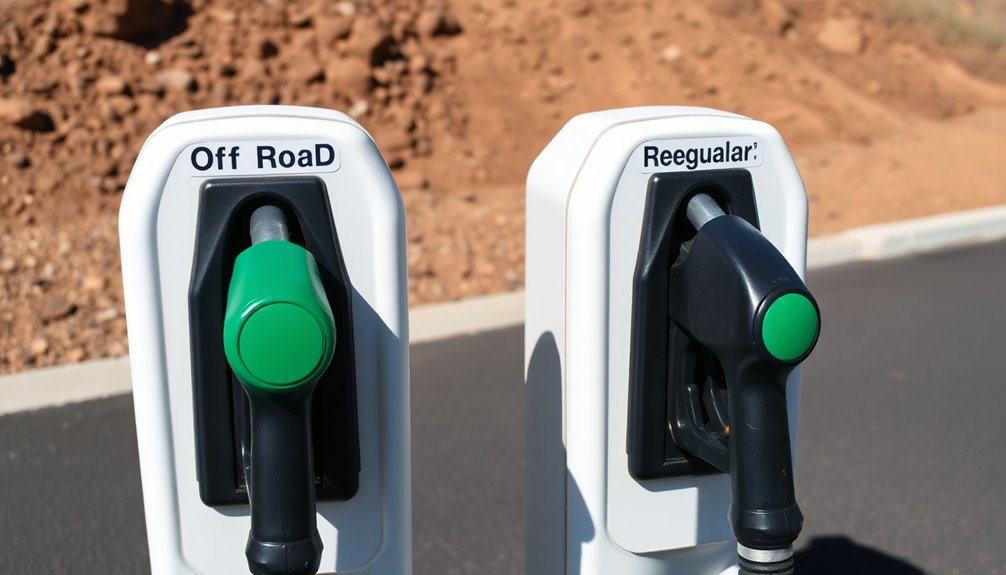
When it comes to understanding diesel fuel types, it's essential to know the distinctions that affect cost and usage. You primarily encounter two categories: on-road diesel and off-road diesel. On-road diesel is the clear fuel you'll find at gas stations, and it's subject to federal taxes, making it pricier.
In contrast, off-road diesel is dyed red to indicate its tax-exempt status, and it's specifically designated for uses like agricultural use and construction equipment.
Both types of diesel are chemically identical and meet Ultra Low Sulfur Diesel (ULSD) fuel specifications, ensuring similar performance capabilities. However, the dye in off-road diesel serves an important regulatory purpose, preventing misuse in on-road vehicles. If you use off-road diesel inappropriately, you could face hefty penalties.
Off-road diesel is typically used in machinery that operates outside public roadways, such as tractors and various construction equipment.
Knowing these differences can help you make informed decisions about fuel purchases, especially if you're involved in industries reliant on specific diesel fuel uses. Understanding these distinctions can lead to significant cost savings and compliance with regulations.
On-Road Diesel Characteristics
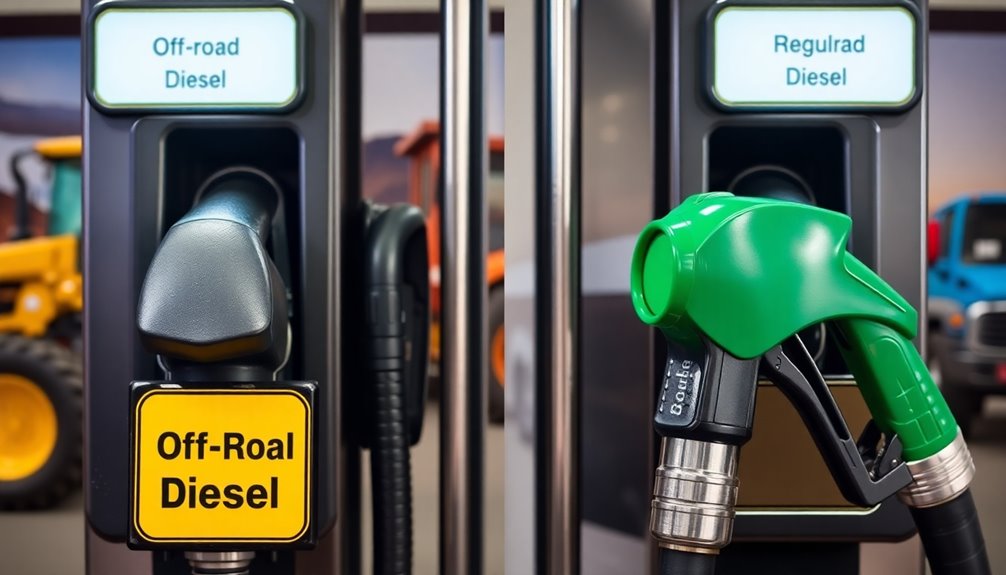
Many people don't realize that on-road diesel, also known as clear diesel, is specifically formulated for vehicles that travel on public roads. This type of diesel must meet stringent emissions regulations established by federal and state authorities, ensuring that it produces fewer pollutants than its off-road counterpart.
On-road diesel typically contains no more than 15 parts per million (ppm) of sulfur, adhering to the Ultra-Low Sulfur Diesel (ULSD) standards put into effect in 2010. This not only makes it cleaner for the environment but also helps vehicles to use diesel more efficiently.
However, one thing to keep in mind is that on-road diesel is subject to federal and state fuel taxes, which can drive up the cost compared to off-road diesel.
You'll find clear diesel readily available at gas stations and retail outlets, making it easily accessible for consumers and commercial vehicles alike.
Off-Road Diesel Characteristics
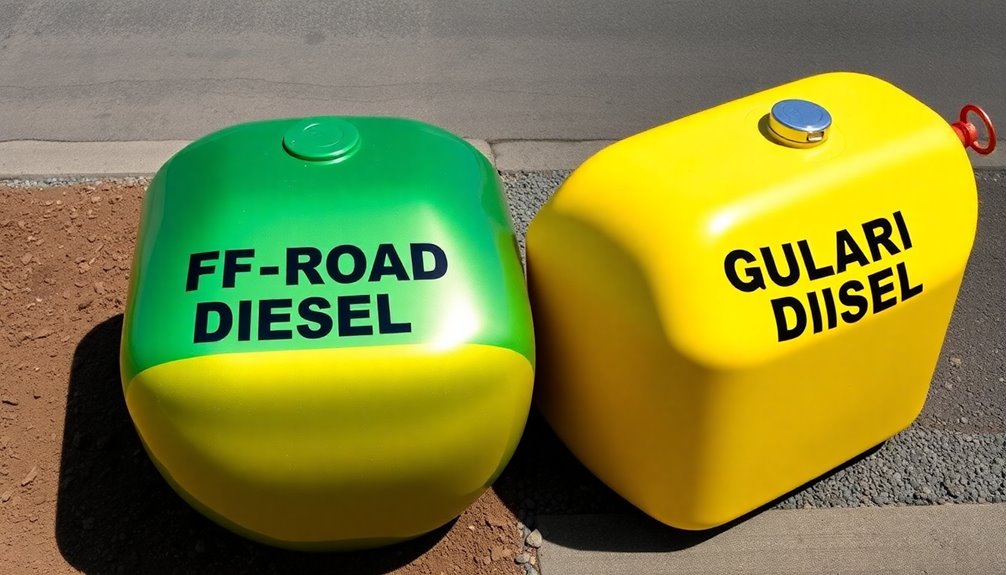
Off-road diesel, or red diesel, comes with tax exemption benefits that can save you money on fuel costs for your agricultural or construction machinery.
The distinctive red color not only identifies it as tax-exempt but also helps authorities guarantee it's used correctly.
Understanding these characteristics is essential to avoid hefty fines and guarantee compliance.
Tax Exemption Benefits
If you're involved in agriculture, construction, or industrial work, understanding the tax exemption benefits of off-road diesel can lead to significant savings.
Off-road diesel is exempt from federal and state fuel taxes, making it cheaper than on-road diesel fuel, which is fully taxed. This exemption is specifically for agricultural, industrial, and construction machinery, and using off-road diesel in on-road vehicles can result in hefty penalties, potentially reaching $10,000 for violations.
Businesses that utilize off-road diesel can save about 25 cents per gallon, translating to substantial cost reductions for high-use industries like construction and agriculture.
The red dye in off-road diesel serves as an identifier for its tax-exempt status, helping law enforcement to monitor and prevent misuse in on-road applications.
Color and Identification
The vibrant red color of off-road diesel, often dubbed "red diesel," is a key characteristic that sets it apart from regular diesel. This distinctive hue comes from dyes like Solvent Red 26 or Solvent Red 164, which are IRS-approved to indicate its tax-exempt status.
Unlike on-road diesel, which is clear and subject to federal and state taxes for public roadway use, off-road diesel is dyed to prevent misuse.
The red dye serves as a deterrent against illegal use in on-road vehicles, where violations can lead to significant legal penalties. By incorporating this visual identification, you can easily differentiate between off-road and on-road diesel through simple visual inspections.
When you see that vibrant red color, you know it's off-road diesel, guaranteeing compliance verification for both users and regulators alike.
Remember, using off-road diesel in an on-road vehicle not only violates tax laws but also undermines the integrity of the system designed to support essential services.
Key Differences Explained
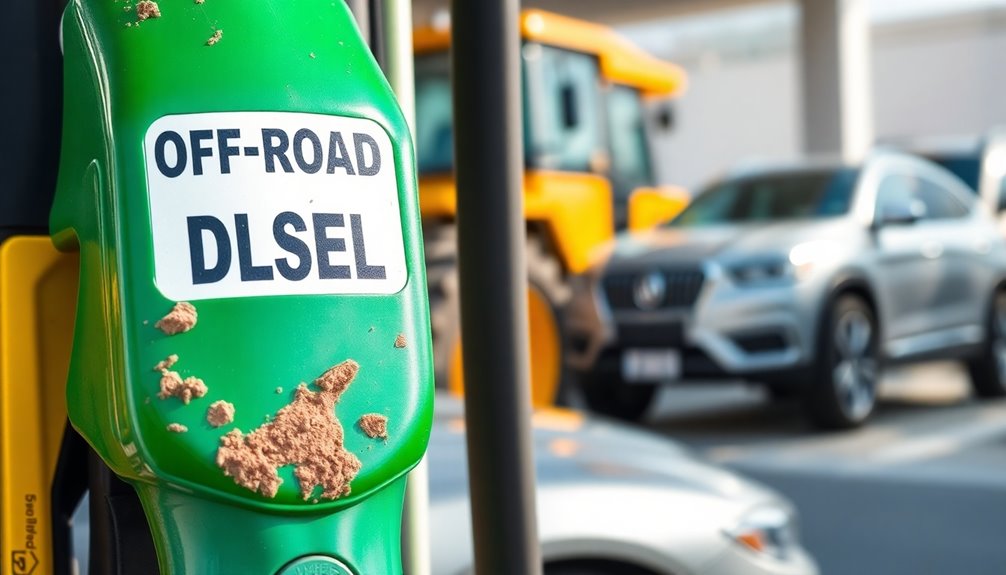
When it comes to diesel fuels, understanding the distinctions can save you money and hassle. Off-road diesel, often dyed red, is tax-exempt and designed for use in agricultural, industrial, and construction machinery. In contrast, regular diesel is clear, fully taxed, and meant for highway use.
Both fuels are chemically identical, adhering to the Ultra Low Sulfur Diesel (ULSD) standards, which limit sulfur content to 15 parts per million (ppm) since 2014.
One of the most significant differences lies in the price; off-road diesel typically costs around 25 cents less per gallon due to its nontaxed status. However, you must remember that using off-road diesel in vehicles on public roadways is illegal and could lead to hefty fines, sometimes reaching up to $10,000 for improper use.
In terms of availability, regular diesel is readily found at gas stations, while off-road diesel is usually sold through bulk distributors. This means you may need to make special arrangements for delivery.
Legal and Regulatory Considerations
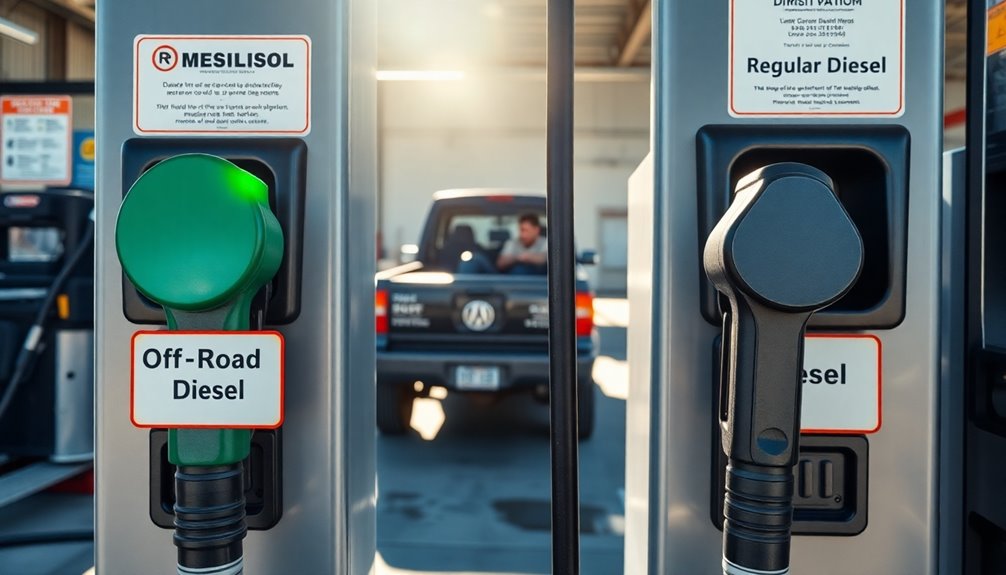
When using off-road diesel, you need to be aware of tax implications and regulations that govern its use.
Misusing this fuel in on-road vehicles can lead to hefty penalties, including fines that can reach $10,000.
It's essential to understand these legal considerations to avoid costly mistakes.
Tax Implications and Regulations
Understanding the tax implications and regulations surrounding off-road diesel is essential for users in the industry. Off-road diesel is exempt from federal and state fuel taxes, making it a more economical choice compared to on-road diesel, which faces hefty taxes due to its use on public roadways.
However, you must adhere to strict regulations to avoid penalties. One vital regulation is that dyed off-road diesel can't be used in on-road vehicles. Doing so is illegal and can lead to fines up to $10,000 for the first offense, reflecting the seriousness of compliance in this area.
Additionally, all diesel fuels, including off-road diesel, must meet Ultra Low Sulfur Diesel (ULSD) standards, with a maximum sulfur content of 15 parts per million (ppm).
States also have varying tax structures for diesel fuel; for instance, while Oregon imposes no taxes on dyed off-road fuel, other states may implement sales taxes. Authorities conduct random checks on diesel trucks, testing for red dye to confirm off-road designation, so staying informed and compliant is vital to avoid unexpected costs and legal issues.
Penalties for Misuse
Misusing off-road diesel can lead to severe penalties, both legal and financial. If you use off-road diesel in your on-road diesel trucks, you risk facing hefty fines and regulatory scrutiny.
It's crucial to understand the implications of using the wrong fuel, as authorities take compliance seriously.
- Fines can reach up to $10,000 for a first offense.
- Random checks, including tank dipping and lab testing, can catch non-compliance.
- The presence of red dye in fuel is a red flag for inspectors.
- Violations of federal and state regulations can impact your business reputation.
- Legal action may result from repeated offenses.
The consequences of misusing off-road diesel aren't just financial; they can also hinder your business operations.
Non-compliance with regulations surrounding high-sulfur diesel in vehicles manufactured after 2007 can lead to even stricter repercussions.
Cost Implications and User Feedback

Many users find that the cost implications of off-road diesel can be significant, especially since it's typically around 25 cents cheaper per gallon than regular on-road diesel due to its nontaxed status.
In industries like agriculture and construction, you might experience substantial savings over time, which can lead to lower operational costs.
However, user experiences vary. While many praise off-road diesel for its affordability, concerns about engine damage and increased maintenance costs arise if it's used improperly. It's essential to use this fuel only in designated equipment to avoid these risks.
Additionally, bulk purchasing options for off-road diesel can enhance your savings further compared to buying on-road diesel at retail prices. By investing in larger quantities, you can capitalize on lower fuel costs.
Yet, anecdotal evidence from community forums highlights mixed feedback. Some users share positive experiences, emphasizing the cost benefits, while others caution against the potential pitfalls of misuse.
Balancing the significant savings with the risks can help you make an informed decision on whether off-road diesel is the right choice for your needs.
Frequently Asked Questions
Is Off-Road Diesel Better Than Regular Diesel?
Whether off-road diesel is better than regular diesel depends on your needs.
If you're in agriculture or construction, off-road diesel can save you money since it's tax-exempt.
Performance-wise, both fuels are similar, so you won't notice much difference in how your engine runs.
However, using off-road diesel in on-road vehicles can lead to fines, so make sure you're using the right type for the right application.
Why Can't I Use Off-Road Diesel?
Picture a roaring engine on a dusty construction site, but now imagine that same engine seized by the law.
You can't use off-road diesel because it's designed for non-road vehicles only. Using it in on-road vehicles is illegal and could lead to hefty fines and penalties.
Authorities conduct random checks, and if you're caught, you might face serious legal trouble.
Stick to regular diesel to avoid those costly repercussions and stay on the right side of the law.
Is Dyed Diesel Bad for Your Truck?
Yes, dyed diesel can be bad for your truck. It contains higher sulfur levels that could damage modern engines designed for low-sulfur fuels.
You'll likely face injector problems and decreased performance if you use it regularly.
Plus, using it in on-road vehicles is illegal and can lead to hefty fines.
To keep your truck running smoothly and within the law, stick to regular diesel specifically formulated for on-road use.
Why Is Off-Road Diesel the Same Price as Regular Diesel?
When it comes to fuel prices, it can feel like a roll of the dice. Off-road diesel might match regular diesel's price due to local supply and demand fluctuations.
Sometimes, bulk purchasing agreements can make off-road diesel more competitive, bringing those costs in line.
Conclusion
In the world of diesel, off-road and on-road fuels dance to different tunes. While on-road diesel fuels your daily drives, off-road diesel fuels the heavy machinery that builds our dreams. Understanding these differences isn't just a matter of fuel; it's about choosing the right energy for your journey. So, whether you're hitting the highway or traversing rugged terrain, knowing your diesel types guarantees you keep your engines purring and your projects rolling smoothly.
